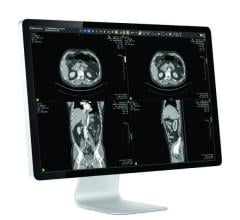Frustrated over healthcare's “failure” to deter the growth of cardiac disease while holding many valuable, predictive tools in their hands, leading physicians take a stand with published report. The SHAPE task force recommends widespread screening with multislice cardiac CT scanning and carotid ultrasound.
CT scanning and carotid ultrasound imaging technologies are at the core of a set of cardiovascular disease screening guidelines for asymptomatic, at-risk populations released this summer by a self-appointed, voluntary group of prominent cardiologists from some of the country's most prestigious cardiovascular institutions.
The Screening for Heart Attack and Prevention and Education Task Force issued its bold recommendations in a report that calls for the noninvasive screening of all asymptomatic men 45-75 years of age and asymptomatic women 55-75 years of age (except those defined as very low risk) to detect and treat those with subclinical atherosclerosis. The executive summary cites the prevalence of cancer screening of asymptomatic populations and, by contrast, the absence of any type of screening for atherosclerosis, which kills more people annually than all cancers combined.
“Cardiovascular healthcare professionals and policymakers are urged to adopt the SHAPE proposal and its attendant cost-effectiveness as a new strategy to contain the epidemic of atherosclerotic cardiovascular disease and the rising cost of therapies associated with this epidemic,” states the executive summary.
According to an Internet news article from heartwire, spokespeople from the AHA, ACC and NHLBI acknowledge the hard work of the Association for Eradication of Heart Attack (AEHA) and the SHAPE task force but also emphasize that the proposed screening protocol was putting the cart before the horse.
"This is a group of scientists and clinicians who are proposing that we change the way we think about heart disease. It's a grassroots organization; it's not a professional society or advocacy society, and these are not AHA/ACC guidelines,” Dr. Pamela Douglas, Duke University and immediate past president of ACC, told heartwire’s reporter. Dr. Douglas was also a member of the SHAPE writing group.
She admitted that to date there has not been a randomized clinical trial to prove and support recommendations for screening large asymptomatic populations.
“We need to test the hypothesis that we can prevent heart disease in the population at large,” Dr. Douglas told heartwire. “This [report] proposes that we do that and provides the rationale for doing that.
"There's no question that there is a sense of frustration about why we haven't done better," Dr. Douglas also said. "Disability and mortality for acute MI has plummeted over the past 20 or 30 years, but at the same time, more people are getting heart disease than ever. It's almost a failure of healthcare that people develop cardiac disease. We know who is going to develop cardiac disease: We have a robust set of risk factors, we've got these screening tools that are diagnostic tests that have been proven in large populations over years and years to predict risk, we have therapeutic agents and therapeutic lifestyle adjustments that have also been proven to protect secondary prevention and even primary prevention. Why can't we put this together and keep people healthy?"
Plenty of opposing viewpoints have surfaced, however, as leading cardiologists from around the country process and react to SHAPE’s assertive call for blanket screening. Several were quoted in author Shelley Wood’s article who expressed pessimism about broadcasting guidelines without evidence-based medicine to back them up.
Bottom line, doctors will have to make up their own minds, at least until AHA and ACC publish their own positions.
The SHAPE report is titled: From Vulnerable Plaque to Vulnerable Patient — Part III: Executive Summary of the Screening for Heart Attack Prevention and Education (SHAPE) Task Force Report, The American Journal of Cardiology, Volume 98, Issue 2, Supplement 1, 17 July 2006, Pages 2-15
Morteza Naghavi, Erling Falk, Harvey S. Hecht, Michael J. Jamieson, Sanjay Kaul, Daniel Berman, Zahi Fayad, Matthew J. Budoff, John Rumberger, Tasneem Z. Naqvi et al. (See www.ajconline.org)
Feature | August 29, 2006
Asymptomatic Screening: ‘Thinking Outside the Box’ or ‘Putting the Cart Before the Horse?’
SHAPE guidelines for CVD screening precede concrete evidence, but give physicians a place to start in preventing heart attack deaths.


 March 06, 2024
March 06, 2024 




